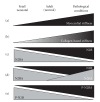Physiologic basis and pathophysiologic implications of the diastolic properties of the cardiac muscle
- PMID: 20625419
- PMCID: PMC2896897
- DOI: 10.1155/2010/807084
Physiologic basis and pathophysiologic implications of the diastolic properties of the cardiac muscle
Abstract
Although systole was for long considered the core of cardiac function, hemodynamic performance is evenly dependent on appropriate systolic and diastolic functions. The recognition that isolated diastolic dysfunction is the major culprit for approximately fifty percent of all heart failure cases imposes a deeper understanding of its underlying mechanisms so that better diagnostic and therapeutic strategies can be designed. Risk factors leading to diastolic dysfunction affect myocardial relaxation and/or its material properties by disrupting the homeostasis of cardiomyocytes as well as their relation with surrounding matrix and vascular structures. As a consequence, slower ventricular relaxation and higher myocardial stiffness may result in higher ventricular filling pressures and in the risk of hemodynamic decompensation. Thus, determining the mechanisms of diastolic function and their implications in the pathophysiology of heart failure with normal ejection fraction has become a prominent field in basic and clinical research.
Figures


References
-
- Lammerding J, Kamm RD, Lee RT. Mechanotransduction in cardiac myocytes. Annals of the New York Academy of Sciences. 2004;1015:53–70. - PubMed
-
- Sussman MA, McCulloch A, Borg TK. Dance band on the Titanic: biomechanical signaling in cardiac hypertrophy. Circulation Research. 2002;91(10):888–898. - PubMed
-
- Orr AW, Helmke BP, Blackman BR, Schwartz MA. Mechanisms of mechanotransduction. Developmental Cell. 2006;10(1):11–20. - PubMed
-
- Swynghedauw B. Phenotypic plasticity of adult myocardium: molecular mechanisms. Journal of Experimental Biology. 2006;209(12):2320–2327. - PubMed
MeSH terms
LinkOut - more resources
Full Text Sources
Research Materials

